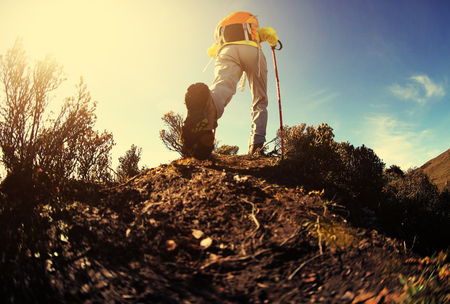Overview of the Appalachian Trail
The Appalachian Trail, often affectionately called the AT, is one of America’s most iconic long-distance hiking trails. Stretching over 2,190 miles from Springer Mountain in Georgia all the way to Mount Katahdin in Maine, the AT winds through 14 states and showcases some of the country’s most beautiful landscapes. It’s more than just a trail—it’s a legendary journey that captures the adventurous spirit of American outdoor culture.
History and Heritage
The idea for the Appalachian Trail was first proposed in 1921 by Benton MacKaye, a visionary forester who dreamed of creating a continuous footpath along the Appalachian Mountains. Construction began in 1923, and after years of dedicated work by thousands of volunteers, the trail was officially completed in 1937. Since then, it has become a symbol of adventure, endurance, and community for hikers across the United States.
The Route: Georgia to Maine
Covering more than 2,190 miles, the AT passes through a diverse range of environments—from lush forests and rolling hills to rugged mountains and remote wilderness. Each state along the route offers its own unique challenges and highlights. Here’s a quick overview:
| State | Miles on Trail | Notable Features |
|---|---|---|
| Georgia | ~78 | Springer Mountain, southern terminus |
| North Carolina & Tennessee | ~388 | Great Smoky Mountains National Park |
| Virginia | ~550 | Blue Ridge Mountains, Shenandoah National Park |
| West Virginia & Maryland | ~41 | Historic Harpers Ferry (ATC headquarters) |
| Pennsylvania | ~229 | “Rocksylvania”—notorious rocky terrain |
| New Jersey & New York | ~162 | Lakes, ridges, and Hudson River views |
| Connecticut & Massachusetts | ~143 | Berkshires and forested hillsides |
| Vermont, New Hampshire & Maine | ~599 | Green Mountains, White Mountains, Mount Katahdin (northern terminus) |
Cultural Significance in American Outdoor Life
The Appalachian Trail holds a special place in American culture. It’s not just about hiking; it’s about community and connection with nature. Every year, thousands of “thru-hikers” attempt to walk the entire length in one go—an incredible feat that takes five to seven months. Even more people enjoy day hikes or section hikes on parts of the trail near their homes. The AT is cared for by a passionate network of volunteers and organizations like the Appalachian Trail Conservancy (ATC), reflecting America’s love for public lands and outdoor adventure.
A Symbol of Adventure and Endurance
The AT is woven into stories, books, movies, and even local folklore. It represents freedom, resilience, and the enduring beauty of America’s natural landscapes—a living testament to what people can achieve when they set out on a journey with determination and an open heart.
Fast Facts About the Appalachian Trail:
| Fact | Description |
|---|---|
| Total Length | 2,190+ miles |
| # of States Crossed | 14 |
| Year Completed | 1937 |
| Main Organizations | Appalachian Trail Conservancy (ATC), US Forest Service |
The Appalachian Trail continues to inspire people from all walks of life to explore the outdoors and challenge themselves—one step at a time.
2. Essential Gear and Preparation
Must-Have Gear for the Appalachian Trail
Thru-hiking the Appalachian Trail means carrying your life on your back for months. Choosing the right gear can make or break your experience. Here’s a breakdown of essentials every hiker should consider:
| Gear Category | Recommended Items | Pro Tips |
|---|---|---|
| Backpack | Lightweight, 50-65L capacity, adjustable harness | Test with full load before you hit the trail |
| Tent/Shelter | Freestanding tent, tarp, or hammock with bug net | Go for something under 3 lbs to save weight |
| Sleeping Bag & Pad | 20°F bag (down or synthetic), inflatable or foam pad | A good night’s sleep is worth the investment |
| Cooking System | Lightweight stove (like Jetboil), fuel, titanium pot, spork | Cold-soaking is an ultralight alternative if you want to skip the stove |
| Clothing | Moisture-wicking base layers, rain jacket, insulated jacket, extra socks/underwear | Synthetic or merino wool dries faster than cotton—ditch cotton completely! |
| Footwear | Trail runners or hiking boots, camp shoes (optional) | Break them in before starting; blisters are a thru-hiker’s worst enemy |
| Water Filtration | Squeeze filter (like Sawyer), backup purification tabs/drops | Chemical treatment is a lightweight backup option for emergencies |
| Navigation Tools | AT guidebook/app (Guthook/FarOut), map, compass (optional) | Your phone is handy but always have a backup power source like a battery bank |
| First Aid & Repair Kit | Duct tape, bandages, blister care, multitool, needle/thread, ibuprofen, personal meds | Treat minor issues early to avoid bigger problems down the trail |
| Trekking Poles | Adjustable poles for stability and reducing knee stress | Saves your joints on steep climbs and descents—worth every ounce! |
| Bear Protection & Food Storage* | Bear bag/canister, odor-proof bags (required in some sections) | *Check regulations—some areas mandate bear canisters! |
Physical Training Tips for Thru-Hikers
The AT covers roughly 2,190 miles from Georgia to Maine—it’s not just a walk in the park. Start training at least three to six months before your hike. Focus on these areas:
- Endurance: Hike local trails with a loaded backpack. Gradually increase distance and elevation gain.
- Strength: Squats, lunges, core work, and step-ups build muscles used on rugged terrain.
- Cardio: Running, cycling, or stair climbing boost overall stamina.
- Pace Practice: Aim to hike at least 10 miles per day comfortably before your start date.
Mental Preparation: The Hidden Challenge of Thru-Hiking
Mental toughness is as important as physical fitness. The Appalachian Trail will test your patience with unpredictable weather, bugs, loneliness, and tough climbs. Here’s how to get ready mentally:
- Set Realistic Expectations: Not every day will be Instagram-perfect. Embrace the hard moments—they’re part of the journey.
- Create a Support System: Let friends and family know your plan so they can encourage you when things get tough.
- Mental Strategies: Practice mindfulness or journaling. Break up the hike into manageable sections rather than focusing on the whole distance.
Your Prep Checklist Before Springer Mountain:
- Ditch unnecessary gear and keep it ultralight—every ounce matters!
- Test all equipment in real conditions; don’t let your first cold night be on the AT.
- Create a resupply plan—know where you’ll stock up on food and fuel along the way.
If you put in the work beforehand—choosing smart gear, training physically, and preparing mentally—you’ll have a much better shot at making it all the way from Georgia to Katahdin.

3. Trail Logistics and Planning
Route Planning: Mapping Out Your Journey
Embarking on a thru-hike of the Appalachian Trail (AT) from Georgia to Maine is a big adventure that needs careful planning. Most hikers start at Springer Mountain in Georgia and finish at Mount Katahdin in Maine, covering about 2,190 miles. The typical northbound (NOBO) hike starts in early spring, while southbounders (SOBO) begin in summer. Its crucial to estimate your daily mileage and plan for zero days (rest days in town). Use trail guides like AWOLs AT Guide or Guthook’s FarOut app to break down your trip into manageable sections.
Sample Section Breakdown
| Section | Distance (Miles) | Estimated Days | Popular Town Stops |
|---|---|---|---|
| Georgia | 75 | 6-8 | Dahlonega, Hiawassee |
| Tennessee/North Carolina | 380 | 30-40 | Franklin, Hot Springs, Erwin |
| Virginia | 550 | 40-50 | Damascus, Waynesboro, Pearisburg |
| Pennsylvania | 230 | 15-20 | Duncannon, Port Clinton, Delaware Water Gap |
| Maine | 280 | 20-25 | Rangeley, Monson, Millinocket (Katahdin) |
Food Resupply Strategies: Staying Fueled on the Trail
The AT crosses many towns where you can resupply with food and essentials. Most hikers carry 3-7 days of food at a time and restock in trail towns or through mail drops. Popular foods include instant oatmeal, tortillas, peanut butter, tuna packets, and energy bars. Some hikers prefer mailing boxes with specialty items to post offices or hostels along the way.
Resupply Options Comparison
| Method | Description | Best For |
|---|---|---|
| Town Resupply | Buy food at local grocery or convenience stores | Flexibility; trying new foods |
| Mail Drops | Ship pre-packed boxes to post offices/hostels | Dietary restrictions; remote sections |
Navigating Town Stops: Where to Rest and Recharge
Towns along the AT are essential for rest days (“zeroes”), laundry, showers, and real meals. Hostels and motels cater to hikers’ needs. Popular stops like Damascus, VA (“Trail Town USA”) offer hiker festivals and shuttles. Plan ahead for accommodations during busy hiking seasons. Many towns have hiker boxes—free exchange spots for unwanted gear or surplus food.
Permits and Regulations: What You Need to Know
You don’t need a permit for the entire AT, but some sections require them:
| Section | Permit Needed? | Description |
|---|---|---|
| Great Smoky Mountains National Park (NC/TN) | Yes | $40 thru-hiker permit; available online or at park entrance |
| Shenandoah National Park (VA) | Yes | No fee; fill out self-registration form at trailhead kiosks |
| Baxter State Park (Maine) | No fee but registration required | Sign up at the park’s Appalachian Trail kiosk upon arrival |
Please respect Leave No Trace principles by packing out all trash and minimizing your impact on the trail environment. Stay updated on regulations as they can change based on weather or trail maintenance needs.
4. Trail Life and Hiker Culture
Hiker Lingo: Speaking the AT Language
If you want to fit in on the Appalachian Trail, learning some hiker lingo is a must. Here are some common terms you’ll hear along the way:
| Term | Meaning |
|---|---|
| Thru-hiker | Someone hiking the entire trail in one season |
| NoBo / SoBo | Northbound (Georgia to Maine) / Southbound (Maine to Georgia) |
| Zero Day | A rest day with no miles hiked |
| Nero Day | A day with nearly zero miles hiked |
| Trail Magic | Unexpected acts of kindness or treats on the trail |
| Trail Name | A nickname adopted on the trail, often based on personality or experiences |
| Hiker Trash | A term of endearment for dirty, happy hikers living simply on the trail |
Trail Angels and Trail Magic: Kindness Along the Path
The Appalachian Trail is famous for its community spirit, especially when it comes to “trail angels.” These generous folks provide “trail magic”—anything from cold sodas to free rides into town. Don’t be surprised if you find a cooler full of snacks at a road crossing or get offered a hot meal by a local volunteer. It’s all part of the AT experience and embodies true American hospitality.
Shelters: A Home Away from Home
Shelters, also called “lean-tos,” are spaced out every few miles along the trail. They offer a simple roof over your head, wooden platforms for sleeping bags, and sometimes a picnic table or fire ring. Sharing stories around these shelters at night is where many hikers form lifelong friendships.
Shelter Etiquette Tips:
- Arrive early—spaces fill up fast during peak season.
- Keep noise down after dark.
- Leave no trace—pack out all trash and gear.
- Share space; make room for late arrivals.
The ‘AT Family’: Finding Your Tramily (Trail Family)
Many hikers form tight-knit groups, affectionately called “tramilies.” These friends may start as strangers but quickly become support systems through shared challenges and triumphs. Whether you’re hiking solo or with others, chances are you’ll connect with people who feel like family by the time you reach Katahdin.
Unique Community Traditions on the AT
The Appalachian Trail has its own set of quirky traditions that add to its charm:
| Tradition / Event | Description |
|---|---|
| Trail Days Festival (Damascus, VA) | An annual celebration where thousands of hikers reunite for music, food, and gear giveaways. |
| Barefoot Hiking Challenge (Pine Grove Furnace State Park) | The tradition of eating a half-gallon of ice cream in one sitting to celebrate reaching the halfway point. |
| Katahdin Summit Photo | A must-do photo op at the northern terminus sign—marking your journey’s end! |
Why It’s Uniquely American
The AT isn’t just a footpath—it’s an iconic slice of Americana. The sense of freedom, rugged self-reliance, spontaneous generosity, and quirky traditions reflect what many love about American culture. On this trail, everyone’s story matters, and everyone’s welcome to join the adventure.
5. Highlights, Challenges, and Pro Tips
Explore the Most Breathtaking Sections
The Appalachian Trail is packed with jaw-dropping scenery and unforgettable moments. Here are some must-see sections:
| Section | Location | Why It’s Special |
|---|---|---|
| Clingmans Dome | Great Smoky Mountains, TN/NC border | Highest point on the AT, sweeping 360° views |
| McAfee Knob | Virginia | Iconic overhanging rock with stunning valley vistas—most photographed spot on the trail |
| Mahoosuc Notch | Maine | Boulder-hopping adventure, often called the “toughest mile” of the AT |
| Franconia Ridge | New Hampshire White Mountains | Miles above treeline with breathtaking alpine scenery |
| Blood Mountain | Georgia | First big climb for northbounders—rewarded by beautiful summit views |
Major Obstacles You’ll Face Along the Way
- Tough Terrain: Expect rocky paths in Pennsylvania (“Rocksylvania”), steep climbs in New Hampshire, and muddy bogs in Vermont.
- Weather Swings: From spring thunderstorms in Georgia to freezing rain in Maine, be ready for everything.
- Bugs and Wildlife: Black flies in New England, mosquitoes in mid-Atlantic swamps, and the occasional bear encounter—bring bug spray and know your bear safety!
- Mental Fatigue: The trail isn’t just a physical challenge; long stretches of solitude can test your mental grit.
- Shelter Crowding: Popular shelters fill up fast during peak season—be flexible with camping plans.
Seasonal Considerations for Thru-Hikers
| Season | Main Considerations |
|---|---|
| Spring (Mar–May) | Muddy trails, unpredictable weather in the South, crowds of northbounders starting out. |
| Summer (Jun–Aug) | Hot & humid mid-Atlantic states, high bugs, water sources can dry up—especially in Pennsylvania. |
| Fall (Sep–Nov) | Cooler temps, beautiful foliage (especially in New England), shorter daylight hours. |
| Winter (Dec–Feb) | Difficult conditions—deep snow in the North, icy trails. Most thru-hikes avoid these months except late-finishers or southbounders starting late summer. |
Hard-Earned Wisdom: Pro Tips for Your AT Thru-Hike
- Pace Yourself: Don’t burn out early—start slow and let your body adjust to daily miles.
- Shoes Over Boots: Most modern thru-hikers prefer lightweight trail runners over heavy boots for comfort and speed.
- No Shame in a Zero Day: Take rest days (“zeroes”) when needed. Your body and spirit will thank you.
- Email Updates Home: Many hikers use free Wi-Fi at trail towns to update family and friends instead of expensive cell data plans.
- Lighter is Better: Every ounce counts! Only carry what you truly need—you’ll be amazed at what you can live without after a few weeks on trail.
- LNT Always: Practice Leave No Trace principles everywhere. Respect the trail so it stays wild for future generations.
You Got This!
The Appalachian Trail is full of both jaw-dropping highlights and tough challenges. With a little planning, flexibility, and determination, you’ll be ready to tackle every mile from Georgia to Maine!


